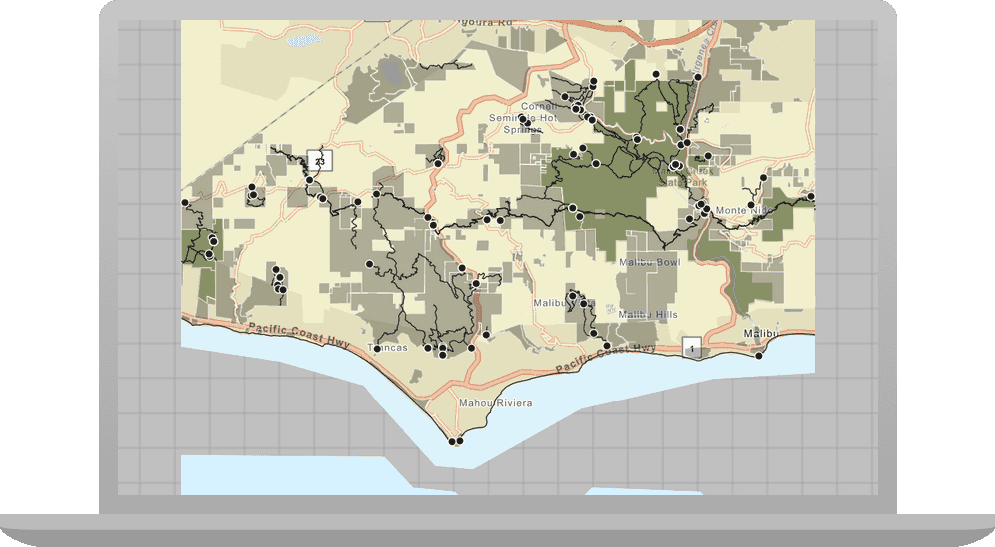Learn how to display a map from a mobile map package (.mmpk file) when you're offline.

In this tutorial you use the MobileMapPackage class to access the .mmpk file, Mahou, and load it to read its contents. The map within the mobile map package contains a basemap layer and data layers and does not require a network connection.
Prerequisites
Before starting this tutorial:
-
You need an ArcGIS Location Platform or ArcGIS Online account.
-
Confirm that your system meets the minimum system requirements.
-
An IDE for Java.
Steps
Open a Java project
-
To start this tutorial, complete the Display a map tutorial, or download and unzip the Display a map solution into a new folder.
-
Open the build.gradle file as a project in IntelliJ IDEA.
Prepare files before coding the app
Modify the files from the Display a map tutorial so they can be used in this tutorial: you will replace imports, change the application title, and remove unnecessary code.
-
In IntelliJ IDEA's Project tool window, open src/main/java/com.example.app and double-click App. Add the following imports, replacing those from the
Display a maptutorial:App.javaUse dark colors for code blocks package com.example.app; import java.io.File; import com.esri.arcgisruntime.loadable.LoadStatus; import com.esri.arcgisruntime.mapping.MobileMapPackage; import com.esri.arcgisruntime.ArcGISRuntimeEnvironment; import com.esri.arcgisruntime.mapping.view.MapView; import javafx.scene.control.Alert; import javafx.application.Application; import javafx.scene.Scene; import javafx.scene.layout.StackPane; import javafx.stage.Stage; public class App extends Application { -
In the
start()life-cycle method, change the title that will appear on the application window toDisplay a map from a mobile map package.App.javaUse dark colors for code blocks @Override public void start(Stage stage) { try { // create the stack pane and JavaFX application scene StackPane stackPane = new StackPane(); Scene scene = new Scene(stackPane); // set title, size, and add scene to stage stage.setTitle("Display a map from a mobile map package"); stage.setWidth(800); stage.setHeight(700); stage.setScene(scene); stage.show(); -
Delete the map, setting the map on the map view, and the map's initial viewpoint. The mobile map package will be used in place of this code later on in the tutorial.
App.javaUse dark colors for code blocks // create a map view to display the map and add it to the stack pane mapView = new MapView(); stackPane.getChildren().add(mapView); ArcGISMap map = new ArcGISMap(BasemapStyle.ARCGIS_TOPOGRAPHIC); // set the map on the map view mapView.setMap(map); mapView.setViewpoint(new Viewpoint(34.02700, -118.80543, 144447.638572));
Add a mobile map package to the project
Add a mobile map package (.mmpk) for distribution with your app.
-
Create or download the
Mahoumobile map package. Complete the Create a mobile map package tutorial to create the package yourself. Otherwise, download the solution file: MahouRiveraTrails.mmpk.Riviera Trails.mmpk -
Copy
Mahouin the system file manager and paste it to the project's root directory in IntelliJ IDEA's Project tool window. See IntelliJ IDEA's documentation for additional methods of importing files for alternative approaches (Import files), if necessary.Riviera Trails.mmpk
Create a mobile map package
Create a MobileMapPackage and assign it to the mobile member variable. Also surround your code with a Java try statement, which will be later followed by a catch that prints a standard stack trace.
public class App extends Application {
private MapView mapView;
private MobileMapPackage mobileMapPackage;
@Override
public void start(Stage stage) {
try {
// create the stack pane and JavaFX application scene
StackPane stackPane = new StackPane();
Scene scene = new Scene(stackPane);
// set title, size, and add scene to stage
stage.setTitle("Display a map from a mobile map package");
stage.setWidth(800);
stage.setHeight(700);
stage.setScene(scene);
stage.show();
ArcGISRuntimeEnvironment.setApiKey("YOUR_ACCESS_TOKEN");
// create a map view
mapView = new MapView();
//Set the location of the .mmpk file to the project root folder
final String mmpkPath = new File(System.getProperty("user.dir"), "./MahouRivieraTrails.mmpk").getAbsolutePath();
mobileMapPackage = new MobileMapPackage(mmpkPath);
Load the mobile map package file and display its map
-
The following code shows how to load the mobile map package (.mmpk) file to get a list of its maps and then select the map you want to display. It also adds the
trystatement's closingcatchstatement.App.javaUse dark colors for code blocks //Set the location of the .mmpk file to the project root folder final String mmpkPath = new File(System.getProperty("user.dir"), "./MahouRivieraTrails.mmpk").getAbsolutePath(); mobileMapPackage = new MobileMapPackage(mmpkPath); mobileMapPackage.loadAsync(); mobileMapPackage.addDoneLoadingListener(() -> { if (mobileMapPackage.getLoadStatus() == LoadStatus.LOADED && mobileMapPackage.getMaps().size() > 0) { //add the map from the mobile map package to the map view mapView.setMap(mobileMapPackage.getMaps().get(0)); } else { Alert alert = new Alert(Alert.AlertType.ERROR, "Failed to load the mobile map package"); alert.show(); } }); // add the map view to stack pane stackPane.getChildren().add(mapView); } catch (Exception e) { // on any error, display the stack trace e.printStackTrace(); } } -
Run the app. Ensure to run the app as a Gradle task and not as an application in your IDE. In the Gradle tool window, under Tasks > application, double-click run.
You should see a map of trail heads, trails, and parks for the area south of the Santa Monica mountains. You can zoom, rotate, drag, and double-tap the map view to explore the map.